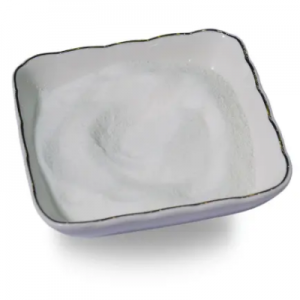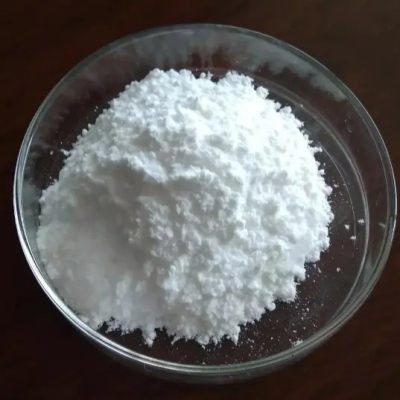3-broMidecarbazole CAS:1592-95-6
Growth promotion: L-Arginine is known to stimulate growth hormone release in animals, which can contribute to improved growth and development. It promotes protein synthesis, which is essential for muscl
In organic synthesis, 3-bromidecarbazole serves as a versatile building block for the preparation of carbazole derivatives. The presence of the bromine substituent introduces specific electronic and steric effects, influencing the reactivity and selectivity of chemical reactions. Chemists utilize this compound in the synthesis of organic materials, dyes, and optoelectronic devices, capitalizing on its unique structural features to tailor the properties of the final products. Applications in Materials Science 3-Bromidecarbazole finds utility in materials science as a precursor for the fabrication of functional materials with carbazole moieties. Its ability to introduce bromine functionality into carbazole-based polymers, coatings, and nanoparticles enables the development of materials with enhanced mechanical, thermal, and electrical characteristics. Scientists harness derivatives of this compound to engineer materials for applications in organic light-emitting diodes (OLEDs), photovoltaic cells, and sensors, driving advancements in energy conversion and sensing technologies. Role in Organic Electronics In the field of organic electronics, 3-bromidecarbazole plays a significant role as a building block for the fabrication of organic semiconductors and light-emitting materials. Its ability to introduce bromine functionality into conjugated systems enhances charge transport properties and molecular packing, leading to materials with improved device performance. Researchers utilize derivatives of this compound to engineer organic electronic devices, such as field-effect transistors, OLEDs, and organic photodetectors, contributing to the development of flexible and wearable electronics, optoelectronics, and display technologies. Contribution to Optoelectronics 3-Bromidecarbazole contributes to the field of optoelectronics by serving as a key component in the synthesis of carbazole-based optoelectronic materials. These materials exhibit tunable photophysical properties, including absorption and emission wavelengths, making them suitable for applications in light-emitting devices and sensors. Incorporating this compound into optoelectronic formulations allows for the development of devices with enhanced performance and functionality, paving the way for advancements in displays, lighting, and sensing technologies. Conclusion In conclusion, 3-bromidecarbazole emerges as a versatile compound with significant implications in organic synthesis, materials science, and optoelectronics. Its unique ability to introduce bromine functionality into carbazole-based molecules makes it a valuable tool for researchers seeking to tailor compound properties for specific applications. The broad applications of 3-bromidecarbazole underscore its role in advancing science, technology, and industry, contributing to the development of innovative materials and devices with improved performance and functionality.
e growth, and can enhance overall body weight gain in animals.
Nitric oxide production: L-Arginine is a precursor for nitric oxide (NO) synthesis in the body. Nitric oxide is involved in various physiological processes, including blood vessel dilation, immune function, and cell signaling. Supplementing L-Arginine in animal diets can enhance NO production, leading to improved blood flow, immune response, and nutrient absorption.
Immune function: L-Arginine plays a crucial role in supporting the immune system. It is involved in the production of immune cells, such as T-cells and macrophages, as well as antibodies. By providing an adequate supply of L-Arginine in animal diets, immune function can be optimized, leading to improved disease resistance and overall health.
Reproductive performance: L-Arginine is essential for reproductive processes in animals. It is involved in sperm production and motility in males and can enhance fertility. In females, L-Arginine supports the development and function of the uterus and placenta, enhancing reproductive performance and increasing litter size.
Stress management: L-Arginine has been shown to have a positive impact on animals' stress response. It can reduce stress-induced cortisol levels and promote a state of relaxation. By supplementing L-Arginine in animal diets, stress tolerance and overall well-being can be improved.



| Composition | C12H8BrN |
| Assay | 99% |
| Appearance | white powder |
| CAS No. | 1592-95-6 |
| Packing | Small and bulk |
| Shelf Life | 2 years |
| Storage | Store in cool and dry area |
| Certification | ISO. |







![(+)-(3r,5s), Tert-Butyl 7-[4-(4-Fluorophenyl)-6-Isopropyl-2-(N-Methyl-N-Methylsulphonylamino)-Pyrimidin-5-Yl]-3,5-Dihydroxy-6(E)-Heptenate (R1.5 Or T-Butyl-Rosuvastatin) CAS:355806-00-7](https://cdn.globalso.com/xindaobiotech/K@NIE7HBAEP6E7J7DS227.png)

![(3S,4R)-4-Acetoxy-3-[(R)-1-(tert-butyldimethylsilyloxy)ethyl]azetidin-2-one CAS:76855-69-1](https://cdn.globalso.com/xindaobiotech/20KKQ1ROFEVXI9DUBYB171.png)